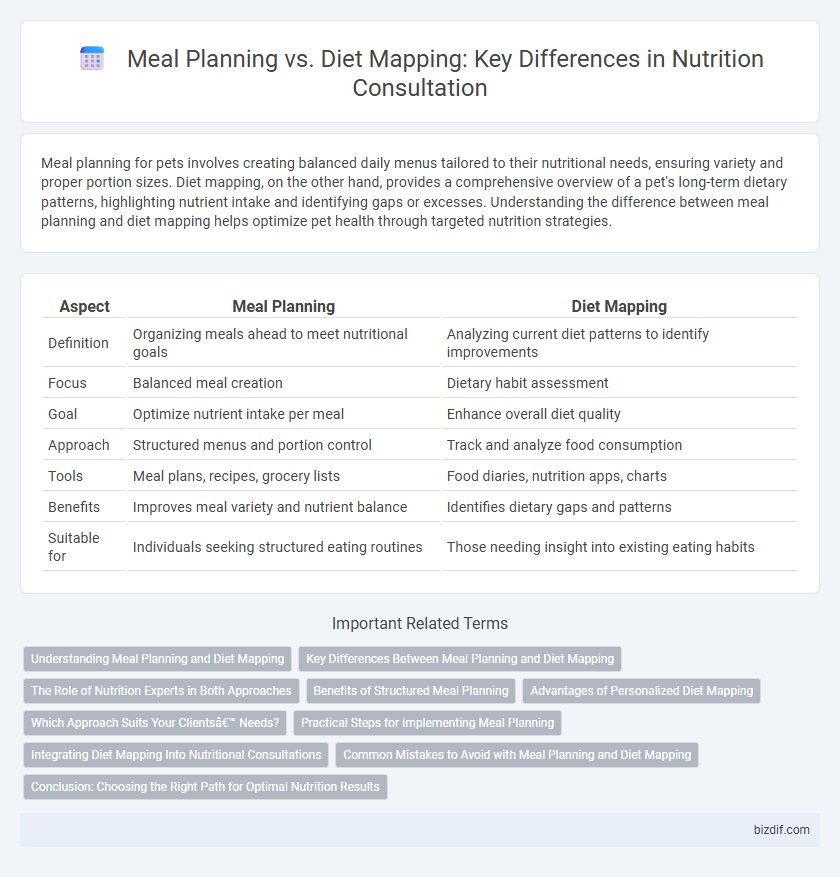Meal planning for pets involves creating balanced daily menus tailored to their nutritional needs, ensuring variety and proper portion sizes. Diet mapping, on the other hand, provides a comprehensive overview of a pet's long-term dietary patterns, highlighting nutrient intake and identifying gaps or excesses. Understanding the difference between meal planning and diet mapping helps optimize pet health through targeted nutrition strategies.
Table of Comparison
| Aspect | Meal Planning | Diet Mapping |
|---|---|---|
| Definition | Organizing meals ahead to meet nutritional goals | Analyzing current diet patterns to identify improvements |
| Focus | Balanced meal creation | Dietary habit assessment |
| Goal | Optimize nutrient intake per meal | Enhance overall diet quality |
| Approach | Structured menus and portion control | Track and analyze food consumption |
| Tools | Meal plans, recipes, grocery lists | Food diaries, nutrition apps, charts |
| Benefits | Improves meal variety and nutrient balance | Identifies dietary gaps and patterns |
| Suitable for | Individuals seeking structured eating routines | Those needing insight into existing eating habits |
Understanding Meal Planning and Diet Mapping
Meal planning involves selecting and organizing meals ahead of time to ensure balanced nutrition and portion control, tailored to individual dietary needs and preferences. Diet mapping focuses on analyzing food intake patterns and nutritional content to identify gaps and optimize health outcomes. Understanding these concepts enables personalized nutrition strategies that promote sustainable eating habits and improve overall wellness.
Key Differences Between Meal Planning and Diet Mapping
Meal planning involves selecting specific foods and portion sizes for each meal based on nutritional goals, preferences, and lifestyle, while diet mapping focuses on outlining overall dietary patterns and nutrient distributions over time. Meal planning offers precise control over daily intake, emphasizing balance and variety in individual meals, whereas diet mapping provides a broader framework for achieving long-term health objectives through structured nutrient timing and macronutrient ratios. Understanding these key differences enhances personalized nutrition strategies by combining detailed meal choices with strategic dietary trends.
The Role of Nutrition Experts in Both Approaches
Nutrition experts play a crucial role in meal planning by tailoring balanced menus that meet individual health needs and lifestyle preferences while ensuring proper nutrient intake. In diet mapping, specialists analyze dietary patterns to identify nutritional gaps and devise strategic adjustments for long-term health improvements. Their expertise ensures both approaches are scientifically grounded and personalized, enhancing adherence and overall effectiveness.
Benefits of Structured Meal Planning
Structured meal planning enhances nutritional balance by ensuring consistent intake of essential macronutrients and micronutrients, supporting overall health and energy levels. It improves weight management through controlled portion sizes and calorie intake tailored to individual goals. Meal planning also reduces food waste and saves time by organizing grocery shopping and meal preparation efficiently.
Advantages of Personalized Diet Mapping
Personalized diet mapping offers tailored nutritional strategies based on individual metabolic profiles, lifestyle, and health goals, ensuring higher adherence and effectiveness compared to generic meal planning. This approach leverages data-driven insights such as genetic markers and gut microbiome composition to optimize nutrient intake and prevent potential deficiencies. Customized diet mapping enhances weight management, boosts energy levels, and supports chronic disease prevention through precision nutrition.
Which Approach Suits Your Clients’ Needs?
Meal planning offers structured daily menus tailored to clients' caloric and nutrient needs, ideal for those seeking clear guidance and routine. Diet mapping emphasizes tracking dietary patterns and preferences over time, suited for clients aiming for long-term behavioral change and flexibility. Selecting between meal planning and diet mapping depends on client goals, lifestyle, and readiness for change, ensuring personalized nutrition strategies enhance adherence and outcomes.
Practical Steps for Implementing Meal Planning
Meal planning involves selecting specific meals and ingredients ahead of time to ensure balanced nutrition and portion control, making it easier to manage daily caloric intake and macronutrient distribution. Practical steps include creating a weekly menu based on dietary goals, preparing grocery lists tailored to nutrient-dense foods, and batch-cooking meals to save time and reduce food waste. Unlike diet mapping, which provides a broad nutritional framework, meal planning emphasizes actionable, detailed preparation for sustainable eating habits.
Integrating Diet Mapping Into Nutritional Consultations
Integrating diet mapping into nutritional consultations enhances personalized meal planning by providing detailed insights into an individual's food preferences, allergies, and metabolic responses. This approach allows nutritionists to develop tailored dietary strategies that optimize nutrient intake and support specific health goals. Utilizing diet mapping tools improves adherence and outcome accuracy by aligning meal plans with real-time dietary habits and lifestyle factors.
Common Mistakes to Avoid with Meal Planning and Diet Mapping
Common mistakes in meal planning include neglecting portion control, ignoring individual nutritional needs, and failing to incorporate variety, which can lead to nutrient deficiencies and poor adherence. In diet mapping, errors such as overcomplicating food tracking, relying on inaccurate data, and not adjusting plans based on progress often result in ineffective outcomes. Avoiding these pitfalls ensures a balanced approach that supports sustainable nutrition goals and overall health improvement.
Conclusion: Choosing the Right Path for Optimal Nutrition Results
Meal planning offers structured, daily guidance focusing on balanced nutrient intake tailored to individual preferences, while diet mapping provides a comprehensive overview of dietary goals and long-term habits. Selecting between these approaches depends on personal lifestyle, health conditions, and sustainability preferences to ensure consistent nutritional success. Integrating both strategies can optimize nutrient timing and goal tracking, leading to improved overall health outcomes.
Meal Planning vs Diet Mapping Infographic

 bizdif.com
bizdif.com